#climate change fiction
Explore tagged Tumblr posts
Text
#Blogtour The Coming Storm by Greg Mosse
It’s a pleasure to take part in the Blogtour The Coming Storm by Greg Mosse. ‘Greg Mosse’s debut novel The Coming Darkness, was a Sunday Times Thriller of 2022, and a Waterstones Thriller of the Month 2022 and widely reviewed. Mosse’s second novel The Coming Storm, sees the return of his anti-hero the French special agent Alex Lamarque, and is part of the new genre of “Cli-Fi Fiction” or Climate…

View On WordPress
#Blogtour#Climate Change Fiction#Climate Fiction#Greg Mosse#Moonflower Books#Speculative#The Coming Darkness 2#The Coming Storm
0 notes
Text

#socialism#communism#democrats#new world order#climate change#republicans#wef#biden#trump#nwo#fiction
1K notes
·
View notes
Text
Review: No More Fairy Tales, anthology edited by D.A. Baden
No More Fairy Tales: Stories to Save the Planet A collection of inspiring, funny, dark, mysterious, tragic, romantic, dramatic, upbeat and fantastical short stories. These 24 stories are written by a variety of authors, with the aim to inspire readers with positive visions of what a sustainable society might look like and how we might get there. The stories are diverse in style, ranging from…
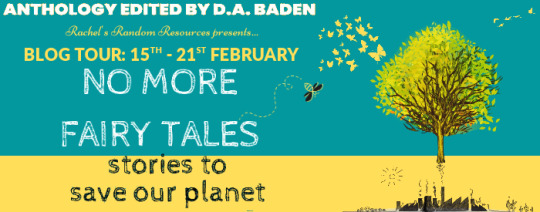
View On WordPress
#@DABadenauthor#@GreenstoriesUK#Anthology#Book review#climate change fiction#Rachel&039;s Random Resources
0 notes
Text
"To change our relationship to the physical world – to end an era of profligate consumption by the few that has consequences for the many – means changing how we think about pretty much everything: wealth, power, joy, time, space, nature, value, what constitutes a good life, what matters, how change itself happens. As the climate journalist Mary Heglar writes, we are not short on innovation. “We’ve got loads of ideas for solar panels and microgrids. While we have all of these pieces, we don’t have a picture of how they come together to build a new world. For too long, the climate fight has been limited to scientists and policy experts. While we need their skills, we also need so much more. When I survey the field, it’s clear that what we desperately need is more artists.”" -Rebecca Solnit. Emphasis added.
Artists are so so important. I've had people tell me they feel bad because, as an artist, they don't think they can contribute anything worthwhile to climate change. They're wrong.
We cannot build a future we cannot imagine. Artists are so important. Artists show us what could be - what we could be
#artists are so so important#climate change#climate crisis#climate news#climate action#quote#quotes#rebecca solnit#literature#climate fiction#clifi#science fiction#the arts#not news#hope#hope posting#solarpunk#hopepunk#excuse my pretentiousness in that last bit pls#art appreciation#artist appreciation#this goes for all types of artists btw!!
351 notes
·
View notes
Text
i'm kind of late to this but i just finished reading the scholomance trilogy by naomi novik and i feel like it is such an underrated urban fantasy?? taking the chosen one trope and turning it on its head with a fmc who has been prophesied to bring death and destruction, who is imbued with terrible power, but cannot even properly use said power to solve any of her obstacles because it would obliterate them and her soul. it takes a tired trope and the idea of an 'overpowered mary sue' and throws it back in your face by showing how all the power and destiny in the world is useless against a system filled with corruption that has burdened you with an easy way out (evil/destructive magic) that you can't take so now you have to work twice as hard as everyone else just to do simple, constructive spells instead of flicking your wrist and being done with it.
#the scholomance#naomi novik#galadriel higgins#orion lake#bookblr#urban fantasy#a deadly education#the last graduate#ya fantasy#the golden enclave#ya fiction#it has a diverse cast#queerness just effortlessly woven in#and the entire thing is so seamlessly crafted with a narrative on what real change looks like#how to really rid your environment of corruption and change society for the better you have to do the gritty work#you have to be willing to do the unpleasant hard grueling organization and working with people / meeting them where they're at#you might not even get to see or do the pretty parts#but its still worth doing the distatesful shit#doing the compromising and giving space for people to learn and make up for mistakes#so that future generations can do better#and have the childhood u didn't#no spoilers in case by some miracle i convince another soul to read this but like#she legit fucking says it in the book#it's not the work she wants to do in the end. not what she envisioned. but she does what she must to make sure other kids don't suffer#makes me think of climate activism so much#we might not get to have the pretty wonderful utopia but we have to be willing to do the shitty stuff it takes to make that future possible
170 notes
·
View notes
Text
The problem that I'm having with a lot of science fiction is that, like...I'm not sure that we, as a culture, know how to move on from the "modernist" understanding of the future; and so we just pretend that the plastic-and-steel, unlimited-growth, better-higher-faster vision of the future that you see in 20th century sci-fi is still viable; or we imagine complete civilizational collapse (or we just set in another universe, or far enough in the future that everyone's out in space and it doesn't matter); but unless you're like...Kim Stanley Robinson, there doesn't seem to be much attempt to thread the needle of, like, "how do we live in the future that we're *actually* building?"
I think that this is a very important question, and also kind of a paradox. Because SF is famously the genre that's supposed to draw on actual scientific findings; but it's also a genre that was born in the modern era and that has modernity bred in its bones.
191 notes
·
View notes
Note
Can you recommend novels for someone going through a very rough patch of life (sick relative, family unravelling)?
Listen, this may seem counterintuitive, but that's literally the best time to read seriously fucked up books. Like, someone important to you is going to die and you have to watch—you don't actually want to feel better, even if it were possible. You want something that's worthy of your grief, something that's bigger and uglier and messier than what you typically go for... but also you don't wanna get stuck reading clown tragedies like A Little Life. I got you.
The Tin Drum by Günter Grass
The Woman in the Dunes by Kobo Abe
Train Dreams by Denis Johnson
Human Acts or The Vegetarian by Han Kang
Blood Meridian by Cormac McCarthy
A Pale View of the Hills by Kazuo Ishiguro
As I Lay Dying by William Faulkner
The Sheltering Sky by Paul Bowles
Hurricane Season by Fernanda Melchor
Jude the Obscure by Thomas Hardy
Lapovna by Ottessa Moshfegh
#may i also rec climate change non-fiction like the sixth extinction & the uninhabitable earth#if it does nothing else it will put things in perspective#anonymous#assbox
92 notes
·
View notes
Text
For decades we dreamed dystopia, and in March of 2020, when COVID crashed upon U.S. shores, it seemed like we had dreamed it so well we wished it into being. While wealthy reactionaries are building actual bunkers and prepping for environmental collapse, fantasizing about which shade of hopelessness our apocalypse will take is a luxury we can no longer afford. By accepting as inevitable humanity’s demise by its own hand, post-apocalyptic fiction places no responsibility on the living to course correct.
These days, climate change isn’t over the horizon, it’s here. The virus that shuts down the globe? We had that, too. Dystopian fiction? That’s so 2012. It’s time we collectively dream of something else. A better world is possible, but if artists and writers are to contribute to that better world, we’re going to need to balance our splendid hellscapes with gardens of earthly delight. We need to envision futures that are livable and happy, and we need to imagine how we get there from here. What’s more, we need to make those worlds as thrilling and engaging as any post-apocalyptic zombie-strewn nightmare.
Fortunately, we don’t need to invent a new literary genre to show us the way to a better tomorrow. Just as there is a left-wing climate movement demanding humanity break from fossil fuels to create a bright future for life on Earth, so is there a parallel climate fiction that allows us to imagine that better world. In steps solarpunk, left-wing literature’s answer to the dystopian novel. Solarpunk looks towards a post-capitalist future of renewable energy. It rejects climate “doomerism” and shows what our collective future could look like if we heal our relationship with the natural world.
Far from Star Trek’s “full luxury space communism,” where humans race across galaxies via endless sources of energy, the technology in solarpunk is imminently achievable. In the anthology Future Primitive: The New Ecotopias, science fiction writer and democratic socialist Kim Stanley Robinson describes this genre as rejecting “the inevitability of the machine future.” Instead it asks, “What is the healthiest way to live? What is the most beautiful?” Rather than Elon Musk’s tent cities on Mars, these fictional worlds “cobble together aspects of the postmodern and the paleolithic, asserting that we might for very good reasons choose to live in ways that resemble in part the ways of our ancestors.”
-via Current Affairs, March 25, 2024
#solarpunk#clifi#scifi#climate fiction#climate change#climate action#hope#hope posting#hopepunk#dystopia#utopia
36 notes
·
View notes
Text
Nausicaä of the Valley of the Wind: Why This is My Favourite Ghibli Movie
CW: Major high-school English teacher vibes ahead. Proceed at your own risk.
Nausicaä of the valley of wind is a story of the titular character Nausicaä and her being a bridge between the world of humans and nature to bring peace, thus fulfilling an ancient prophecy.
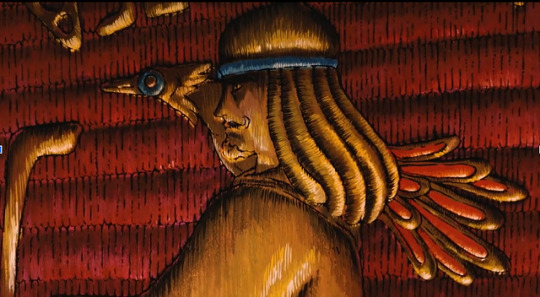
Nausicaa is the princess of the Valley of the Wind. The film begins with her walking and exploring the Sea of Decay, an area with toxic air, plants and fungal spores. She collects some spores and finds the hard molten shell of an Ohmu (gigantic blue-blooded trilobite-looking creatures), which her people use to make weapons and tools. As the name suggests, the Valley of the Wind is a civilisation that depends on and bases their culture around wind, which one can see through an abundance of windmills and gliders, including the one that Nausicaä rides. They are shown to be peaceful people who do not interfere with the politics of the warring human kingdoms or disturb nature. Nausicaä in particular is shown to have a special gift with animals—from calming Ohmus to having a pet fox-squirrel. As the existence of the kingdom depends on the sea wind that shields them from the effects of the sea of decay, there is a general reverence towards nature and its other members such as the Ohmus, that are often referred to with honorifics.
This was an element I liked: the symbolism goes deep in this film; for example, with the nature of wind—it being the very breath necessary for life is contrasted with its other face, through toxic spores in the sea of decay capable of killing anyone who inhales it.
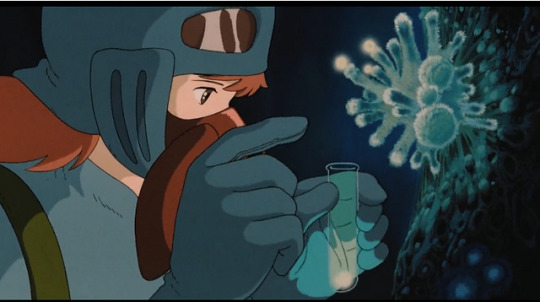
It is revealed that humans had built The Giant Men, weapons so dangerous—not unlike our atomic bombs as shown through the characteristic mushroom cloud—that the destruction caused by the war had unleashed the fury of the Ohmus, an otherwise gentle species. They wiped out entire civilisations and where they died, the Sea of Decay grew on their decomposing corpses, showing how all life is interconnected and that even in death the rage of the Ohmus, and through them the rage of nature, wouldn't subside. It is then that the viewers find out that this is not some far-off planet, but a post-apocalyptic future on earth.
New species of plants and fungi made the Sea of Decay their habitat—nature and life always find a way. It is implied that the humans lost the war referred to as the Seven days of Fire, but the truth is that it is not a war that can ever be won. Even if you win the war against nature you lose. As the story progresses, we see that the plants and fungi that Nausicaä collected from the Sea of Decay are actually trying to purify the soil and water—nature holds no grudges but only seeks balance.

The seventh of the Giant Men, a sentient atomic bomb if you will, apparently hid underground for a thousand years until the kingdom of Pejite found it for use against their enemy, the Tolmekians. They both remain oblivious to the sheer destruction that can be caused by this Giant Man and they don't care either. Despite the balance between humans and nature being a delicate one, instead of trying to rebuild together, they justify to themselves that the war is necessary for self-preservation and to put humans back on top of the food chain.
In their hubris, the Tolmekians and their princess Kushana believe that with the help of their superweapon they can destroy the Sea of Decay despite knowing that it will trigger the wrath of the Ohmus. The Giant Man however is not complete and hence, though the devastation is great, the final giant man dies and all that remains to be done is to calm the wrath of the Ohmus.
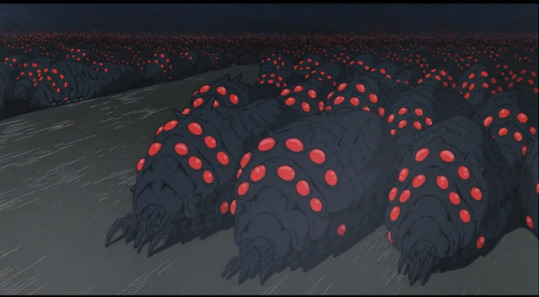
Nausicaä saves an Ohmu child who was injured by Tolmekian soldiers to lure the Ohmus into a war. She saves the baby Ohmu and sacrifices her own life to calm the sea of maddened Ohmus. The now-calm Ohmu then revive Nausicaä, symbolising the mystical healing power of nature and its ability to support and create life.
Nausicaä is an excellent protagonist, and how the trope of the chosen one is utilised is beautiful and full of symbolism. Right from the get-go, we see her being inquisitive and brave. She is willing to defend her people but not through violence. And it is made abundantly clear that her avoidance of violence is not due to any lack of strength; when she strikes down the soldiers who killed her father, rather than feeling any sense of pride (as one might expect from a character not used to strength), it sickens her. She shows understanding even towards Kushana, whose men took over her kingdom. She sincerely loves and respects animals and plants.
There was a prophecy among the people of the valley of wind that a person clad in blue over golden fields will save their kingdom and bring peace. And towards the end of the film, Nausicaä's clothes becoming blue with the blood of the baby Ohmu she saved and the golden fields being the tendrils of the Ohmus healing her is poetic to say the least.
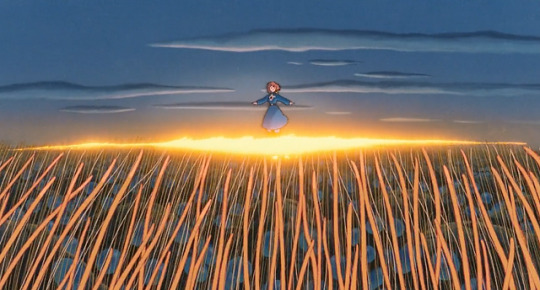
In addition to a good female protagonist, we also get a powerful female antagonist in Kushana, who starts out as a one-note expansionist ruler, but it is revealed that she lost her limbs and got severely maimed by the sea of decay, motivating her to destroy it once and for all. Proud and arrogant, sure, but she has a motive beyond just wanting power and possesses some form of a moral code. In another story she could be the protagonist bravely defending humanity against the evil, alien-esque trilobites and spores.
It was a unique and meaningful choice on Miyazaki's part to symbolise nature through the Ohmus—alien-looking giant insects—instead of something cute and fluffy. Oftentimes humans care more about the conservation of animals that they find cute (pandas over, say, Panamanian golden frogs), but an animal doesn't have to appeal to human aesthetics to be worth conserving.
Absolutely not to be missed is the breathtaking soundtrack by Hisaishi. There are symphonies, techno music, sitar-like instruments and a child's humming, all elevating every scene to give a moving experience.
Ultimately it is an ambitious story that aims to deal with themes of coexisting with nature, the futility and dangers of war, and of how innocent children who should live carefree lives are dragged into it and made heroes. This film is often categorised as falling into the genre of Solarpunk: a literary and artistic movement that centres around building a sustainable future interconnected with nature and community. Although this film does depict violence and wars, it ultimately shows a peaceful future is possible.
Truly a masterpiece. 9/10.
#analysis#culture#short essays#media#anime#fictional characters#film#ghiblicore#studio ghibli#musings#movies#solarpunk#climate change#nuclear#environmental issues#environment#miyazaki#feminism#review#character analysis#nausicaa#animanga#animals
234 notes
·
View notes
Text
The Power Of Media

I need do address one thing, because I see that kinda mindset creep up again and again.
Basically, under postings about utopian media, be it Star Trek, Solarpunk, or - heck - just bare Hopepunk, sometimes people will just go: "Media does not do shit. It does not change the world."
And that just is... demonstrably fault and a very defeatist attitude.
Now, one thing first: Yes, media on its own will not change the world. It will not. If you have this mindset, you are right in so far. We can have endless amounts of hopeful media and the world will not change from it.
But...
We live in capitalism. Its power seems inescapable. So did the divine right of kings. Any human power can be resisted and changed by human beings. Resistance and change often begin in art, and very often in our art, the art of words. - Ursula K. LeGuin
This quote of Ursula K. LeGuin is very powerful to me. Because it really captures the issue very well.
See. Right now we get bombarded with capitalist propaganda left and right. It already starts in school, we will often get it at home and obviously in media again and again.
It is so hard to escape, that to many it is hard to imagine that there ever could be anything else. I mean, we even have the issue within Solarpunk. When I read through those Solarpunk Anthologies, I will again and again find stories, that feature either capitalist worlds - or a world that has to be rebuild after the apocalypse. Because people really struggle imagining how it could be otherwise.
And this is why fiction is so important. Why Hopepunk is so important.
A lot of young people right now are able to see that the system is broken, that it has left them behind. Most young folks, who do not come from generational wealth, see that they will under the current system never own their own house. Their own retirement seems to be rather unlikely. And that is, if they do not die before from either the effects of climate change, from some pandemic through which we have to work because line needs to go up, or just in general because the health care system does not take care of them.
And these young people are willing to fight. They are. But right now they are only fighting against a system. They do not know what they fight for.
I know, for some this might sound like a small thing. But it is not. Especially not in a world, where more and more people are struggling with their mental health.
People need hope.
And again: No, it is not enough on its own. Just hopeful fiction on its own runs the danger of just being endless escapism.
We also need to offer mutual aid for each other. We also need to organize. And, yeah, we need to protest and actually get out there to fight.
But don't underestimate the power of fiction, when it comes to giving people something to fight for.
We know that media and stories have these powers. It is, after all, why those in powers dripfeed us the kinda stories that vilify those, who want to change the system. That tell us, that "everything is fine, okay, just trust the good billionaires" and what not. Because they understand this power.
And we should not leave this power to them along.
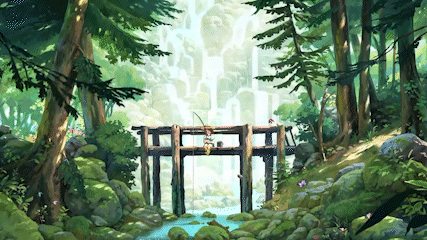
#solarpunk#lunarpunk#hopepunk#utopia#utopian fiction#the power of fiction#the power of media#hope is a dangerous thing#it only needs a spark#fighting climate change
252 notes
·
View notes
Text
Solarpunk Magazine Issue 18 Released!
And it's on sale for $4 through this weekend! Check out our website for all of our issues.
20 notes
·
View notes
Text
Pretend you are the sea. Pretend you are a life-filled veil of green and gold and black and blue covering 70 percent of the land and most of its mysteries. Some day soon you will choke on refuse. A growing knot of bottles and bags and tires and zipties and rubber duckies and microbeads and bright plastic bric-a-brac will catch fast in your throat, suffocating all life from your deep places. You’ll bloat like a dead thing, an albatross chick’s belly packed tight and stretched grotesque with all the indigestible junk you’ve been fed. And when the last coral has withered—when the final whale has sung her question to an empty abyssal plain and there’s not even a hagfish left to mourn her passing—you will rise primeval, stinking of pig effluent and rotting fish, mercury and motor oil, an entire undead ecosystem marching on the cities of the coast.
63 notes
·
View notes
Text
Wow, maybe there really is magic in creativity 😅
Two months ago we made Earthsong, a game about an endangered parrot called a kākāpō in New Zealand repopulating in a new place.

Here's an article I found a few weeks later, about these birds being introduced to other islands: https://www.popsci.com/environment/kakapo-parrot-new-zealand/
I know it's just a fun coincidence, but it's cool when game dev aligns with the world like this!
You can play the jam version of the game here, but be aware that it's buggy and rushed! I'm still working on the updates!
Edit: since this post is getting traction, let's consider other forms of action to help the environment!
#earthsong#earth song#twine interactive fiction#twine game#twine games#twine wip#solarpunk#climate change#ecology#synchronicity
108 notes
·
View notes
Text
Solarpunk is nice and all but what about grolarpunk? It's when all the grolar bears (grizzly + polar, occurring as a result of the warming Arctic) create an apocalyptic setting and that's where your story takes place.
#scifi#solarpunk#bears#speculative fiction#dystopia#post apocalypse#post apocalyptic#climate change#shitpost#grolar bears#grolarpunk
107 notes
·
View notes
Text
Postericide - Is committed when humanity is put at risk of extinction by conduct performed either with the intention of making humanity go extinct, or with the knowledge that the conduct is fit to have this effect.
So if you go against whatever they are pushing, they will charge you for the crimes they are guilty of. 🤔
#pay attention#educate yourselves#educate yourself#knowledge is power#reeducate yourself#reeducate yourselves#think about it#think for yourselves#think for yourself#do your homework#do your own research#do some research#ask yourself questions#question everything#news#postericide#climate crisis#climate change#facts#stranger than fiction#stranger things#nothing is as it appears#nothing is as it seems#nothing is real#crimes against humanity
32 notes
·
View notes
Text
instagram
Grist 2200 is an amazing site to read climate fiction stories! They host a competition every year for climate fiction, and the winners they choose are really spectacular, and they're great reads. You can find the stories here.
Grist on its own is already gorgeous reporting on climate, and it's non-profit journalism, so make sure they're in your rotation as well.
#solarpunk#sustainability#climate change#climate crisis#climate fiction#hope#fiction#writing#Instagram
17 notes
·
View notes